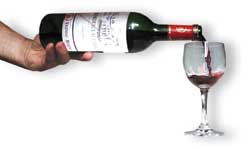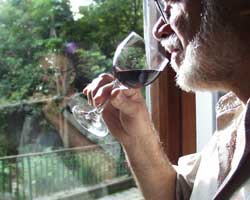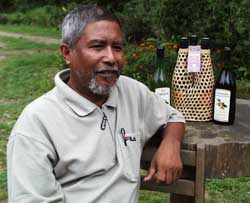 I find myself once again pressed into service as wine columnist for Nepali Times. Of course, this is a great honour, but as with all great honours, it carries with it a heavy burden of responsibility. Though the publication schedule of one column every three years might appear to lessen this burden, in fact it only exacerbates it. Some local journalistic competition on this topic would help, but it apparently does not yet exist.
I find myself once again pressed into service as wine columnist for Nepali Times. Of course, this is a great honour, but as with all great honours, it carries with it a heavy burden of responsibility. Though the publication schedule of one column every three years might appear to lessen this burden, in fact it only exacerbates it. Some local journalistic competition on this topic would help, but it apparently does not yet exist.  The first bit of advice I must provide is to not pay too much attention to whatever advice I offer. Newcomers to the world of wine often remind me of many in the mid-eighties who were just learning to use a computer, they seemed convinced that if they did something wrong, something terrible would happen. Now, of course, computers have been relegated to the same category of appliances as CD players and electric razors: just plug it in and go. But somehow, drinking wine is seen as fraught with threatening obstacles and potentially disgracing disasters.
The first bit of advice I must provide is to not pay too much attention to whatever advice I offer. Newcomers to the world of wine often remind me of many in the mid-eighties who were just learning to use a computer, they seemed convinced that if they did something wrong, something terrible would happen. Now, of course, computers have been relegated to the same category of appliances as CD players and electric razors: just plug it in and go. But somehow, drinking wine is seen as fraught with threatening obstacles and potentially disgracing disasters.
The words "serious" and "wine" should not be found in the same sentence, with several obvious exceptions, such as "Iraq is suffering a serious shortage of wine". If it becomes clear that someone is in fact "serious" about wine, I suggest serving them beer or not inviting them at all. The serious wine drinker is often the rotten cork of a dinner party.
I am encouraged by recent informal research that has led me to the conclusion that many Nepalis apparently do not suffer from these sorts of inhibitions. A completely uncontrolled survey at a recent large tamasha revealed that 49.7 percent (statistical reliability of plus or minus 100 percent) of those attending chose unidentified red or white wine over the conspicuously imported scotch that was being proffered in sloshing trays of tumblers. So, if wine seriousness and appreciation are not local problems, what's the problem?
Apparently the market has responded to local wine appreciation (and lack of inhibition), and the choices now available far exceed the capacity of the casual researcher to fully assess the opportunities for success (and failure) that now abound.
There are numerous wines available in Kathmandu that are good to drink and (considering how far they must come, and how they must get here) are reasonably priced. I have had a great deal of success in the Rs 495-700 range. In Nepal, the most important date on the bottle is not the vintage, but the date of its importation, which is indicated on the duty sticker. Unless it is clear that a bottle imported in 1997 has led a pampered life in air conditioned comfort, it is probably safe to assume that it has led a tortured existence fraught with heat, cork desiccation, fluorescent lighting (a plague on all living beings), and overall lack of respect.
Wine is a living thing. Though it is true grapes that undergo some stress in their growing can contribute desirable character to the finished product, the same is not true of stress endured once the product is finished. So, try to buy bottles imported this year or last.
Once you have checked the duty sticker, you can go on to the second number, the vintage. The 2000 vintage of Bordeaux brings tears of gratitude to the eyes of the Bordelais. Even the cheap stuff can be good. One great red success in this category is Chateau des Sables, a so called "cru bourgeois". What it lacks in pedigree in makes up for in taste. I wish I could find this at Rs 495 in the States. Another red Bordeaux worthy of consideration is a simple "Bordeaux Superieur" bottled by Valensac-Marency for Rs 650. This wine will be better in a couple of years, but in case you don't have that kind of time, a little artificial respiration does wonders. Many people know to let a young red wine breathe by opening the bottle an hour or so before drinking it, but this actually does very little. This is why I suggest taking a more active role with wines that are a bit harsh, and transferring the wine to another glass container: a lot more breathing goes on, and the transformation can be miraculous. More important than the specific vintage, it is more important to remember that reds age more gracefully than whites. In Kathmandu, one should generally avoid whites over three or four years old.
Two wonderful surprises in the red category that surfaced at a recent tasting inspired by this assignment were an Italian Barbera d'Asti, La Rovere, 1998 (Rs 695) and a Cabernet-Malbec from, of all places, Mexico. The first was a surprise because of the bottle, which was frosted in order to give the appearance of being dusty. I generally avoid wine in bottles that seem to be trying too hard, but this was excellent: the lightest of the reds we tasted, but interesting and rich in its own way. I purchased the Mexican El Mecedor (from Baja California, the southern part of California that Mexico got to keep) out of curiosity and as a kind of joke. I had never heard of Mexican wine, much less seen or tasted it, and it seemed as unlikely as Nepali seafood. Wonder of wonders, this Mexican wine (Rs 625) was perhaps our favorite of all: rich, a bit fruity, easy to like, and, as one of the jury said, with "aspirations of greatness". I regret to add that we may have consumed the last (and only) bottle in the Valley.  The grand prize in the white category also came from the 2000 vintage of Bordeaux. This was a humble Chardonnay bottled by Leon Galhaud from the Pays d'Oc region (Rs 667): well made, with a nice balance of fruitiness and dryness. Other winners were from Australia, which reliably produces wines at fair prices that are easy to like. Lindeman's Bin 77 Semillion-Chardonnay blend, 2000, and their Bin 65 Chardonnay, 2001, both at Rs 684, were both a bit more fruity and less restrained than their French competition: hardly a surprise, given who made them.
The grand prize in the white category also came from the 2000 vintage of Bordeaux. This was a humble Chardonnay bottled by Leon Galhaud from the Pays d'Oc region (Rs 667): well made, with a nice balance of fruitiness and dryness. Other winners were from Australia, which reliably produces wines at fair prices that are easy to like. Lindeman's Bin 77 Semillion-Chardonnay blend, 2000, and their Bin 65 Chardonnay, 2001, both at Rs 684, were both a bit more fruity and less restrained than their French competition: hardly a surprise, given who made them.
Though the Valley seems awash in wine (and beer), I must end this article on a somewhat sombre note.
ecently, while at a feast, I was offered ela, and was rather disappointed when two bottles of Bagpiper appeared instead of that wonderful local fire water made from rice or baji. On Sankranti, I noticed among the feasters at Ta Bahal in Patan some folks who had bottles of San Miguel sitting on the ground beside their laptes of baji, chhuela, and aluya achar. A bhwe is just not a bhwe without ela and th?n, the latter being that wonderful not quite bubbly, not quite sweet, not quite sour, milky beverage that was a required part of the finale to long pujas twenty years ago. I wish that there were some way of making these two beverages, in their wonderful authentic and varied forms, available in ways so that they could take their rightful places alongside the Johnny Walkers and San Miguels in the Bluebirds, Namastes, and Green Lines of the Valley, and thus be valourised by the market economy that now seems to be so readily dominated by foreign intruders.
Wine facts  Nepal consumes some 14,000 bottles of imported wines a year, and this amount is growing rapidly as habits and social mores change.
Nepal consumes some 14,000 bottles of imported wines a year, and this amount is growing rapidly as habits and social mores change.
One reason for the popularity of imported wines in Kathmandu is low prices. But how a good bottle of French wine is the same cost in Nepal as in France? Abishek Agarwal of Greenline Centre a leading wholesaler of liquor, says this is because exporters have a special price for South Asia, Nepal's import duty on wine is only 40 percent (compared to 200 percent in India), local taxes and department store margins are much lower here than elsewhere in Europe.
"The Nepali market for high grade wines is very small, most people look for cheaper wines, hence table wines and cooking wines are more popular among locals," says Abishek Agarwal.
Middle class Nepalis are also getting more health conscious and shifting from hard liquor to wines. What is good news for wine dealers is not so good news for the breweries: because wine is so cheap many people are also drinking less beer. "The wine business in Nepal is growing at 10 percent per year, and it is getting increasingly popular in urban areas where people are leaving the home-made brews for wines," says Pawan K Agarwal of PK Impex, the other big importer of foreign wines in Nepal.
Made in Nepal
HEMLATA RAI
 Twenty years ago, Satya Lal Ranjitkar petitioned King Birendra to promote indigenous wines to increase the income of rural people. The king was impressed and ordered sales tax and excise duty exemption for five years.
Twenty years ago, Satya Lal Ranjitkar petitioned King Birendra to promote indigenous wines to increase the income of rural people. The king was impressed and ordered sales tax and excise duty exemption for five years. Later, the government reversed this decision and forced the industry to close down after labelling it illegal for not paying tax that they had been excused from. Nepal's wine industry has no chance when the government overturns royal edicts and lumps it in the same tax bracket as hard alcohol.
Still, it speaks for the perseverance of our wine makers that they have soldiered on with fine drinks professionally made from Himalayan wild berries and fruits.
"The wine industry has been victimised by those who manipulate public misconception about alcohol for their own benefit," says Maheshwor Lal Ranjitkar of Makalu Wine Industry (pic, left), maker of the famous Hinwa label. The wine is produced by fermenting fruits and contains only up to 17 percent alcohol.
 Satya Lal's horticulturist son Madhusudan went to France to learn wine-making and returned with all the skills but they are lying fallow: the legal hassles, official discouragement, and limited consumers disheartened him. Madhusudan now runs a school.
Satya Lal's horticulturist son Madhusudan went to France to learn wine-making and returned with all the skills but they are lying fallow: the legal hassles, official discouragement, and limited consumers disheartened him. Madhusudan now runs a school. Maheshwor Lal refuses to give up. When the government waived taxes for wine industries in 16 remote districts, he set up MWI in Sankhuwasabha a decade ago. Until the Maoists forced its closure in 2000, MWI was producing 40,000 bottles of wild mulberry wine per year.
But there may yet be a happy ending: the Maoists no longer object to the factory. Hinwa is still available at Kathmandu supermarkets, but it faces stiff competition from cheap imported grape wines.
"Our policies are such that it discourages Nepali wine industry in cost of increased dependency on imported wine," says Shishir Ranjitkar of Fermented Beverage Industry (FBI) which is planning to import its own wines. The roadmap is clear: put wine makers on a different tax bracket than distilleries and protect it with excise exemption like King Birendra did.


